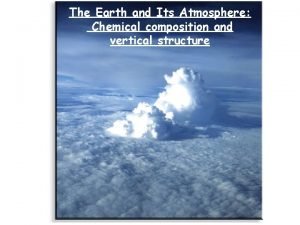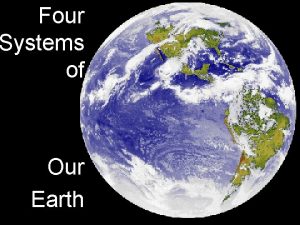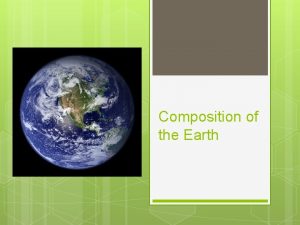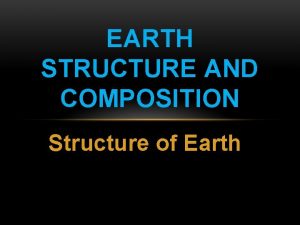Four Systems of Our Earth Composition of Earth














- Slides: 14

Four Systems of Our Earth

Composition of Earth l Earth Has 4 main systems that interact: Earth’s systems Atmosphere Hydrosphere Biosphere Geosphere Air/gases water life land/rock

The Atmosphere– layer of gas that surrounds Earth more commonly known as “air”.

Composition of Earth l The Atmosphere l Mostly Nitrogen and Oxygen l Water vapor is responsible for clouds and precipitation l Has layers l Protects us from meteors and comets, x-rays, gamma rays, ultra violet light

Composition of Earth’s atmosphere The Atmosphere layers Exosphere § Thermosphere § Mesosphere § Stratosphere § Troposphere

Troposphere § § Contains most clouds and weather. Temperature cools as you go higher 50% of sun’s energy passes through, 50% is reflected back. Most of the troposphere’s heat is from Earth (convection) Exosphere

Troposphere and Clouds l l Among other gases there is water vapor in the troposphere. Clouds—form when air rises, cools to its dew point, and becomes saturated (moist).

Troposphere Air pressure— air weight that varies over Earth’s surface. l l l Warmer air is less dense and exerts less pressure. Cooler air is more dense and exerts more pressure.

Stratosphere l Stratosphere § § § 10 km to 50 km contains ozone that absorbs much of the Sun’s ultraviolet radiation. Gets warmer as you go up.

Mesosphere l Mesosphere 50 -85 km § The coldest part of the atmosphere. § It can get down to -90°C in the mesosphere. §

Thermosphere l Thermosphere § 80 -500 km § Temperatures increase up to 1, 700°C § Filters out x-rays and gamma rays from the sun. § This is an image of the space shuttle as it is orbiting around the Earth. § The space shuttle orbits in thermosphere of the Earth.

Exosphere l l l The last layer of the atmosphere Difficult to tell where it stops and space begins Very few atoms in this layer of the atmosphere

Atmosphere Exosphere--The last layer of the atmosphere, Difficult to tell where it stops and space begins, Very few atoms in this layer of the atmosphere Thermosphere-- The air is really thin that high up. The temperature changes with the solar activity. If the sun is active, temperatures in thermosphere can get up to 1, 500°C or higher! Mesosphere--The temperature drops when you go higher, like it does in the troposphere. Coldest part of the atmosphere Stratosphere--from 10 km to 50 km above Earth’s surface, this layer contains ozone that absorbs much of the Sun’s ultraviolet radiation. Troposphere--Contains most clouds and weather. , Most of the troposphere’s heat is from Earth, Temperature cools about 6. 5 degrees Celsius per kilometer of altitude.

Ionosphere l Within the mesosphere and thermosphere is a layer of electrically charged particles. This layer allows radio waves to travel across the country to another city.
 Thinking affects our language which then affects our
Thinking affects our language which then affects our Our census our future
Our census our future Longing for peace our world is troubled
Longing for peace our world is troubled Marcus aurelius our life is what our thoughts make it
Marcus aurelius our life is what our thoughts make it We bow our hearts
We bow our hearts Our census our future
Our census our future Our life is what our thoughts make it
Our life is what our thoughts make it Poet of money madness
Poet of money madness Awareness of ourselves and our environment is
Awareness of ourselves and our environment is Our awareness of ourselves and our environment
Our awareness of ourselves and our environment God our father christ our brother
God our father christ our brother Our future is in our hands quotes
Our future is in our hands quotes Our awareness of ourselves and our environment.
Our awareness of ourselves and our environment. Our awareness of ourselves and our environment
Our awareness of ourselves and our environment Earth's atmosphere composition
Earth's atmosphere composition



























